[English] 日本語
 Yorodumi
Yorodumi- PDB-1p1l: Structure of the Periplasmic divalent cation tolerance protein Cu... -
+ Open data
Open data
- Basic information
Basic information
| Entry | Database: PDB / ID: 1p1l | ||||||
|---|---|---|---|---|---|---|---|
| Title | Structure of the Periplasmic divalent cation tolerance protein CutA from Archaeoglobus fulgidus | ||||||
 Components Components | Periplasmic divalent cation tolerance protein CUTA | ||||||
 Keywords Keywords | STRUCTURAL GENOMICS / UNKNOWN FUNCTION / T835 / NYSGXRC / PSI / Protein Structure Initiative / New York SGX Research Center for Structural Genomics | ||||||
| Function / homology |  Function and homology information Function and homology information | ||||||
| Biological species |   Archaeoglobus fulgidus (archaea) Archaeoglobus fulgidus (archaea) | ||||||
| Method |  X-RAY DIFFRACTION / X-RAY DIFFRACTION /  SIR / Resolution: 2 Å SIR / Resolution: 2 Å | ||||||
 Authors Authors | Kniewel, R. / Buglino, J.A. / Lima, C.D. / Burley, S.K. / New York SGX Research Center for Structural Genomics (NYSGXRC) | ||||||
 Citation Citation |  Journal: To be Published / Year: 2003 Journal: To be Published / Year: 2003Title: Structure of the Periplasmic divalent cation tolerance protein CutA from Archaeoglobus fulgidus Authors: Kniewel, R. / Buglino, J.A. / Lima, C.D. | ||||||
| History |
|
- Structure visualization
Structure visualization
| Structure viewer | Molecule:  Molmil Molmil Jmol/JSmol Jmol/JSmol |
|---|
- Downloads & links
Downloads & links
- Download
Download
| PDBx/mmCIF format |  1p1l.cif.gz 1p1l.cif.gz | 32.6 KB | Display |  PDBx/mmCIF format PDBx/mmCIF format |
|---|---|---|---|---|
| PDB format |  pdb1p1l.ent.gz pdb1p1l.ent.gz | 22.3 KB | Display |  PDB format PDB format |
| PDBx/mmJSON format |  1p1l.json.gz 1p1l.json.gz | Tree view |  PDBx/mmJSON format PDBx/mmJSON format | |
| Others |  Other downloads Other downloads |
-Validation report
| Summary document |  1p1l_validation.pdf.gz 1p1l_validation.pdf.gz | 413.6 KB | Display |  wwPDB validaton report wwPDB validaton report |
|---|---|---|---|---|
| Full document |  1p1l_full_validation.pdf.gz 1p1l_full_validation.pdf.gz | 414.9 KB | Display | |
| Data in XML |  1p1l_validation.xml.gz 1p1l_validation.xml.gz | 6.7 KB | Display | |
| Data in CIF |  1p1l_validation.cif.gz 1p1l_validation.cif.gz | 8.3 KB | Display | |
| Arichive directory |  https://data.pdbj.org/pub/pdb/validation_reports/p1/1p1l https://data.pdbj.org/pub/pdb/validation_reports/p1/1p1l ftp://data.pdbj.org/pub/pdb/validation_reports/p1/1p1l ftp://data.pdbj.org/pub/pdb/validation_reports/p1/1p1l | HTTPS FTP |
-Related structure data
| Related structure data | |
|---|---|
| Similar structure data | |
| Other databases |
- Links
Links
- Assembly
Assembly
| Deposited unit | 
| ||||||||||
|---|---|---|---|---|---|---|---|---|---|---|---|
| 1 |
| ||||||||||
| 2 | 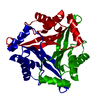
| ||||||||||
| Unit cell |
|
- Components
Components
| #1: Protein | Mass: 11900.855 Da / Num. of mol.: 1 Source method: isolated from a genetically manipulated source Source: (gene. exp.)   Archaeoglobus fulgidus (archaea) / Gene: CUTA / Production host: Archaeoglobus fulgidus (archaea) / Gene: CUTA / Production host:  |
|---|---|
| #2: Water | ChemComp-HOH / |
-Experimental details
-Experiment
| Experiment | Method:  X-RAY DIFFRACTION / Number of used crystals: 2 X-RAY DIFFRACTION / Number of used crystals: 2 |
|---|
- Sample preparation
Sample preparation
| Crystal | Density Matthews: 2.51 Å3/Da / Density % sol: 50.6 % |
|---|---|
| Crystal grow | Temperature: 291 K / Method: vapor diffusion, hanging drop / pH: 5.6 Details: 21% PEG 1500, 0.1M Na Citrate pH 5.6, 3% MPD, 0.15M Magnesium Chloride, 0.2M Ammonium Sulfate, VAPOR DIFFUSION, HANGING DROP, temperature 291K |
-Data collection
| Diffraction |
| ||||||||||||||||||
|---|---|---|---|---|---|---|---|---|---|---|---|---|---|---|---|---|---|---|---|
| Diffraction source |
| ||||||||||||||||||
| Detector |
| ||||||||||||||||||
| Radiation |
| ||||||||||||||||||
| Radiation wavelength | Wavelength: 1.5418 Å / Relative weight: 1 | ||||||||||||||||||
| Reflection | Resolution: 2→20 Å / Num. all: 8551 / Num. obs: 8551 / % possible obs: 93.7 % / Observed criterion σ(F): 0 / Observed criterion σ(I): 0 / Biso Wilson estimate: 25.6 Å2 / Rmerge(I) obs: 0.048 / Net I/σ(I): 37.3 | ||||||||||||||||||
| Reflection shell | Resolution: 2→2.07 Å / Rmerge(I) obs: 0.118 / Mean I/σ(I) obs: 11 / % possible all: 79.5 |
- Processing
Processing
| Software |
| ||||||||||||||||||||||||||||||||||||
|---|---|---|---|---|---|---|---|---|---|---|---|---|---|---|---|---|---|---|---|---|---|---|---|---|---|---|---|---|---|---|---|---|---|---|---|---|---|
| Refinement | Method to determine structure:  SIR / Resolution: 2→19.4 Å / Rfactor Rfree error: 0.011 / Isotropic thermal model: RESTRAINED / Cross valid method: THROUGHOUT / σ(F): 0 / Stereochemistry target values: Engh & Huber SIR / Resolution: 2→19.4 Å / Rfactor Rfree error: 0.011 / Isotropic thermal model: RESTRAINED / Cross valid method: THROUGHOUT / σ(F): 0 / Stereochemistry target values: Engh & Huber
| ||||||||||||||||||||||||||||||||||||
| Solvent computation | Solvent model: FLAT MODEL / Bsol: 52.6094 Å2 / ksol: 0.398561 e/Å3 | ||||||||||||||||||||||||||||||||||||
| Displacement parameters | Biso mean: 26 Å2
| ||||||||||||||||||||||||||||||||||||
| Refine analyze | Luzzati coordinate error free: 0.27 Å | ||||||||||||||||||||||||||||||||||||
| Refinement step | Cycle: LAST / Resolution: 2→19.4 Å
| ||||||||||||||||||||||||||||||||||||
| Refine LS restraints |
| ||||||||||||||||||||||||||||||||||||
| LS refinement shell | Resolution: 2→2.07 Å / Rfactor Rfree error: 0.031 / Total num. of bins used: 10
| ||||||||||||||||||||||||||||||||||||
| Xplor file |
|
 Movie
Movie Controller
Controller


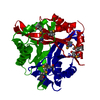


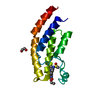

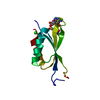
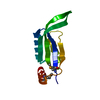



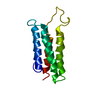
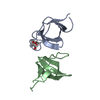
 PDBj
PDBj
